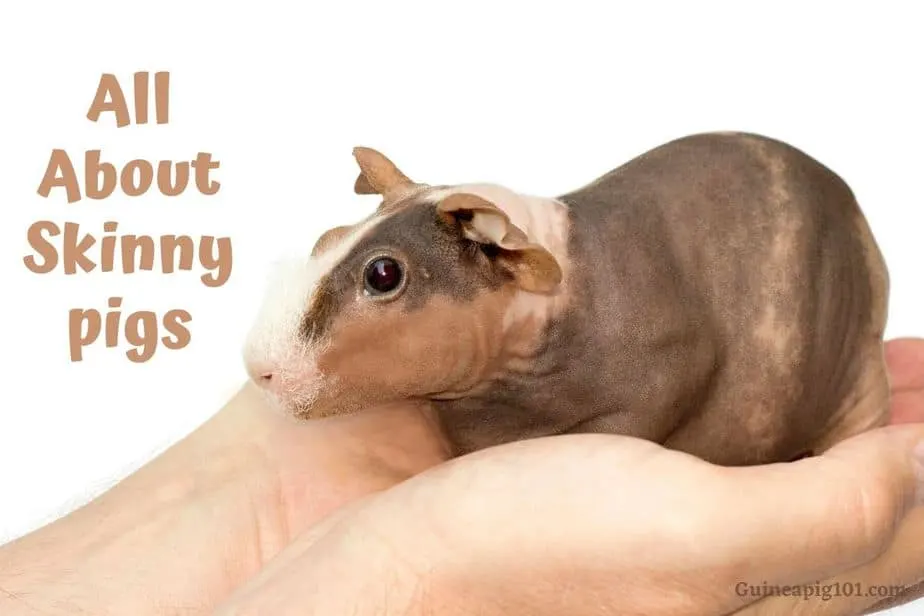The skinny guinea pig has one of the most distinct looks among all other guinea pigs breed. Their body is almost hairless; thus, they look quite thinner as compared to others; hence the name skinny pigs came up.
Skinny pigs have some hair around their muzzles, feet & legs but not a single patch of hair elsewhere. They might not look as fluffy as other guinea pigs breed, but they do have soft & smooth skin all-around their bodies.
I was looking to get a skinny pig for myself and started doing some research over the internet and forums. What I quickly noticed was there is not enough information about them available over the internet.
So, I decided to learn more about them and consult a few experts and gather as much information as I can. Once I figured out all about their origin, diet, habitat, grooming and skincare need, etc. I decided to pen everything down for you guys.
So here we are, if you are also looking for a complete guide where you can learn everything about skinny pigs, then read this guide till the end, and I shall ensure that you get all the essential info about them.
What is a skinny pig?
Skinny guinea pigs are the hairless breed of guinea pigs, also known as hairless guinea pigs which were first discovered in the late ’70s. There was a result of a specific lab breeding process with some hairless lab strain.
These guinea pigs usually don’t have any hair in their body at the time of their birth. However, with time, they do develop some hairs around their nose and feet.
To learn more about them let us begin by understanding how & when they originated.
Skinny pig origin
The hairless guinea pigs were first discovered in Montreal’s Armand Frappier Institute in 1978, in a colony of Hartley lab guinea pigs. They were a result of spontaneous cross-breeding between a haired guinea pig and hairless lab strain.
They were used in the laboratory for dermatology tests until the ’80s when they were sent to other labs for breeding. Soon after that, they became an exotic and rare breed among breeders and gain popularity it has today.
They are one of the newest breeds of guinea pigs, which are not yet recognized by the American Cavy Breeders Association. The first of the kind was not healthy at all. In fact, they were very ill, indeed. They had some breeding issues in the beginning, unable to survive even the most common diseases.
Most of them passed away very young. However, over time with evolving breeding techniques and careful breeding practices, they have managed to live quite healthy and long.
Many experts argue that skinny pigs have a shorter lifespan and weaker immunity than other haired breeds. However, there is no concrete evidence to prove the same.
So, now that you know the basics about how skinny pigs were originated let us now learn about there appearance in brief.
What does a skinny pig look like?
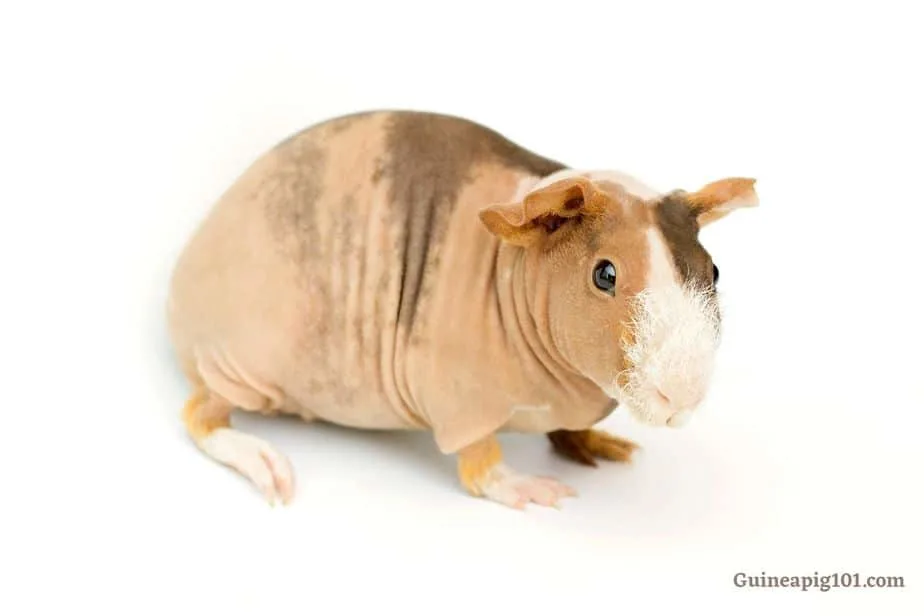
The physical appearance of a skinny guinea pig is quite distinct from all other breeds.
Unlike other guinea pigs who have a fluffy & soft coat, these pigs have almost no hair in their entire body.
They do develop small hair around their nose and feet as they grow older but have smooth, soft skin around their bodies.
Skinny pig size: How big does a skinny pig get?
A skinny pig can grow up to 10 inches in length. The length is dependent on a variety of factors, including genes, diet & care provided, etc. Let us have a look at their growth rate:
| Age | At Birth | 8 weeks | 16 weeks | Maturity |
|---|---|---|---|---|
| Growth Rate | 3-4 inches | 5-6 inches | 7-8 inches | 9-10 inches |
As you can see, the skinny guinea pig is usually just 3-4inches in size when they are born. The average litter size is 3, and the size of the guinea pigs at this phase depends on litter size as well.
The smaller the litter, the larger the size. Just like their other breed members, these guinea pigs grow at a lightning pace. Only from birth to the first eight weeks they almost get double in size.
Usually, by eight weeks, they grow up to 5-6 inches in length. After that, they still grow quick but not at such a rapid rate.
They are usually 7-8 inches in length by the end of 16 weeks. Moving ahead, they continue to grow at a languid pace until they hit the maturity mark and get up to 9-10 inches in length.
The skinny pigs are usually a little shorter than usual guinea pigs breed. The size of the skinny pig is dependent upon a lot of factors.
Typically, male skinny pigs are a little longer than female ones. However, most owners will not notice the slight difference.
Skinny pig weight: How much should a skinny pig weigh?
A mature skinny pig can weigh anywhere between 800-1100 grams. While female piggies weigh a little less than males, it may depend upon a lot of factors like diet, habitat, temperature, etc.
Let us have a closer look at what the normal weigh at different age looks like.
| Guinea Pig Weight | New Born | 8 Weeks | Maturity |
| Weight Growth | 80-100 grams | 450-500 grams | 800-1100 grams |
A newborn skinny pig weighs anywhere between 80-100 grams depending upon the genetics and litter size.
As they grow and hit the eight weeks mark, they can weigh anywhere between 450-500grams. At this phase, you can tell the difference in weight between the male and female guinea pigs. The male will weigh a little more, and that is entirely normal.
Once they pass the eight weeks mark, they tend to grow slowly. They will grow slowly and reach the weight of 800-1100 grams until they hit maturity.
At this point, you can see a weight difference of about 100 grams in male and female skinny pigs. While the male skinny pigs are a little heavier than female piggies, the matrix may sometimes vary.
It would help if you kept a close watch at the weight of your skinny pigs. Tracking their weight weekly can help in understanding more about their health.
While a slight difference of 10-20 grams every week can be neglected, a 30-50grams weight change should raise your alarm, and you should start looking for the cause.
If there is a change of 50+grams, you need to visit a vet immediately. Such a significant difference might be a sign of some severe health issue which we have not yet detected.
Skinny pig colors:
Skinny pigs can be found in a wide variety of patterns and colors. Some of the most common ones are tortoiseshell, dutch, Himalayan, dalmatian & many more. While some of the most common colors of skinny pigs are:
- Chocolate brown
- Black
- Cinnamon
- White
- Golden
- Grey &
- Pink
There are many more colors available. While some are more common than others, not all colors are available at all places. So, it might be tough to find the exact color you want in your area nearby.
Skinny pig life span: How long does a skinny pig live?
The average lifespan of a skinny pig is around 4.5 years. One can comfortably live up to 5-6 years if provided with the right kind of diet and care.
Some skinny guinea pigs have lived for over seven years; however, they are a rare occurrence.
I would definitely recommend you to read our article on How to increase the lifespan of guinea pigs and what do they generally average to learn more about it.
Skinny pig temperament
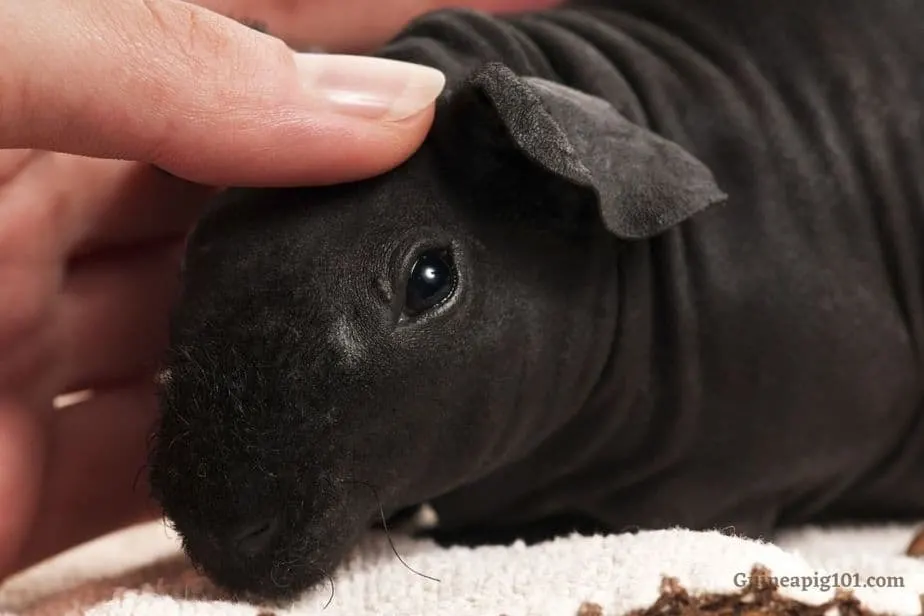
Just like their appearance, the temperament of skinny pigs is quite distinct from other breeds out there. While other guinea pig breeds are very active & playful, these ones are very calm, well-behaved and affectionate in nature.
They show the least dominance behavior and usually don’t want to get into any heated moments. Skinny pigs are also social and enjoy being cuddled and petted.
They can remain very calm in your arms and usually don’t try to get away like other guinea pig breeds.
However, just like other beings, every guinea pig is different; thus, the behavior may differ from one piggy to another. In general, most skinny pigs do carry all these traits.
Skinny pig care
Skinny pigs are one such breed of guinea pig which need some extra care as compared to other kinds out there.
The essential requirement of food, healthcare, toys, hiding, etc. remains the same for them. However, there are a few things like the temperature of the room, skincare & beddings, which we might need to pay a closer look at.
With that out of the way, let us have a closer look at what they need in terms of diet, habitat, grooming, etc.
Skinny pig diet plan: What do skinny pigs eat?
The dietary needs of skinny pigs are quite similar to other guinea pig breeds.
Hay is the staple part of their diet, which will be around 80% of the total intake. Fresh Vegetables and fruits fulfill the rest 15%, and pellets are what goes in the last 5%.
Apart from these, there can be some treats added once a week or so to spice things up.
We have an in-depth article written about the guinea pig diet, where you can learn more about their diet plan in detail.
Hay
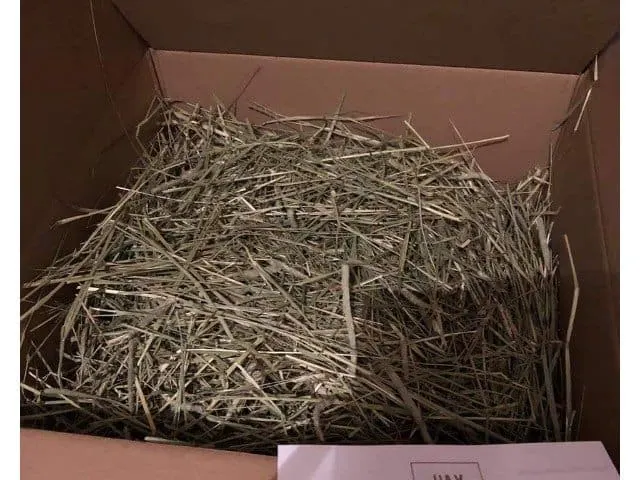
Hay is the staple part of their diet and needs to be available in plenty at all times. There is a wide range of hay available in the market. What you need for guinea pigs is either Timothy hay or orchard hay. Make sure you get either of these only.
Timothy hay is the perfect choice for most owners; however, some owners are allergic to it, and for them, the closest alternative would be orchard hay.
You should definitely avoid other hay-like oats or alfalfa hay as these hay doesn’t contain the right balance of nutrients needed by our guinea pigs. Since hay is an essential part of their diet, you don’t want to provide them with the best balance which their body needs.
Some cheap brands often mix timothy hay with some alfalfa hay to bring the cost down. Using such hay can be terrible for your guinea pigs as the calcium content in that hay is quite high, and it can lead to bladder stones in guinea pigs.
You can save some money on hay by going cheap, but the vet bills later might be ten times more than what you would save.
Fresh Vegetables
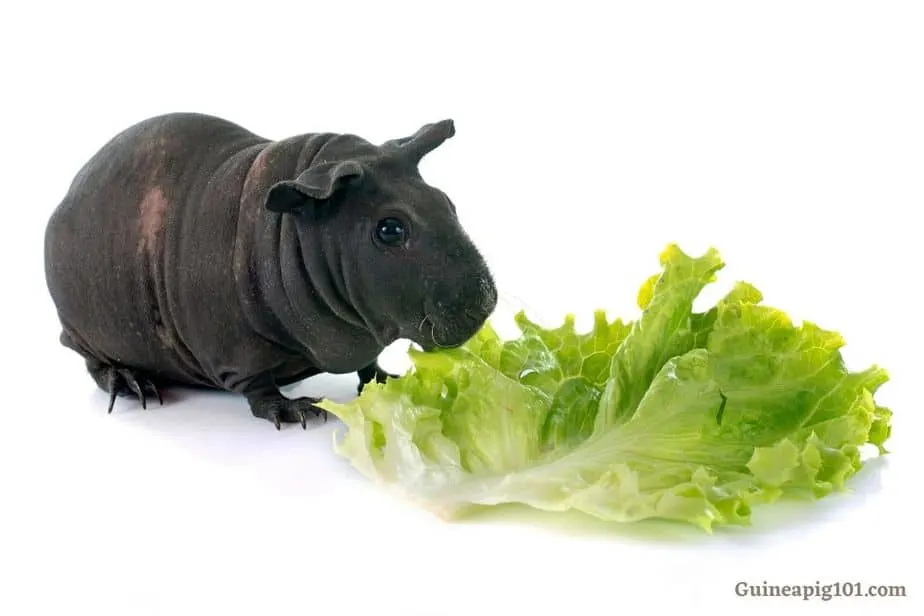
Fresh vegetables are an essential part of your guinea pig’s diet. It takes around 15% of their total intake. However, it is a crucial part of the diet as well.
While guinea pigs get most of their carbs, fibers and other nutrients from hay, they get a significant chunk of Vitamin C and other essential Vitamins from vegetables.
Unlike other animals, guinea pigs cannot produce their own vitamin C; thus they are dependent upon veggies and fruits for getting the same.
Most experts recommend serving at least 5-6 different types of vegetables to your guinea pigs daily. While the quantity of the same should not exceed one cup daily, you can divide it into two parts and serve twice daily to make the diet more even throughout the day.
Also, make sure you choose healthy vegetables and fruits that are low in calcium and high in Vitamin C.
Vegetables like Bell Peppers, cilantro, lettuce are some great choices that you can feed daily. Apart from that, spinach, tomatoes, carrots, zucchini, cucumber, kale, parsley are some other popular choices that most guinea pig owners go with.
Please note: Guinea pigs have a sensitive digestive system, and they cannot tolerate a significant change in their diet. A significant change can easily upset their system balance, and they might suffer from diarrhea and other health issues. Always make sure you introduce new food slowly to ensure you don’t set their system off-balanced.
Pellets
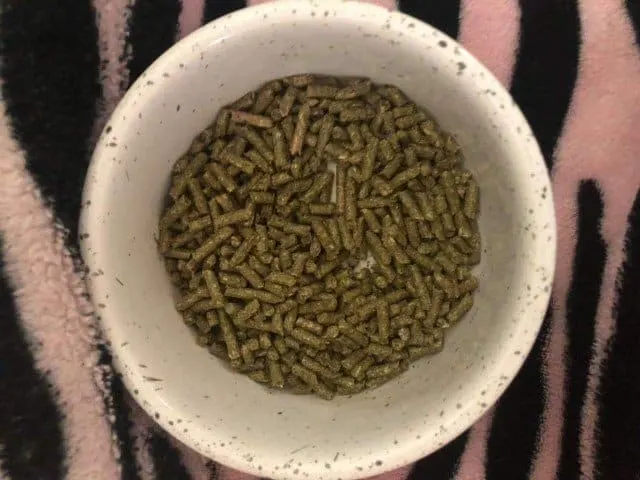
Pellets are also an excellent addition in your guinea pig’s diet. Most guinea pig pellets are fortified with extra Vitamin C, which helps in keeping up with their nutrients upkeep.
Pellets can provide all-round nutrients, including Fiber, Carbs, Vitamins, and other Minerals needed by your guinea pigs.
It is definitely not the substitute for vegetables in your guinea pig’s diet. However, it does help in keeping up the nutrients need of your guinea pigs that are picky in their choice of food.
Always serve 1/8 cup-1/6 cup of pellets to your guinea pigs daily. I find refilling the bowl every day or whenever needs works fine as your guinea pigs are not going to munch on pellets like crazy. So, the chances of overfeeding are quite low.
However, they do toss it around or tip over the bowl or even pee/poop over it, which can result in lots of wastage if you overfill the bowl. So, serve minimal whenever you are and refill whenever necessary.
Treats
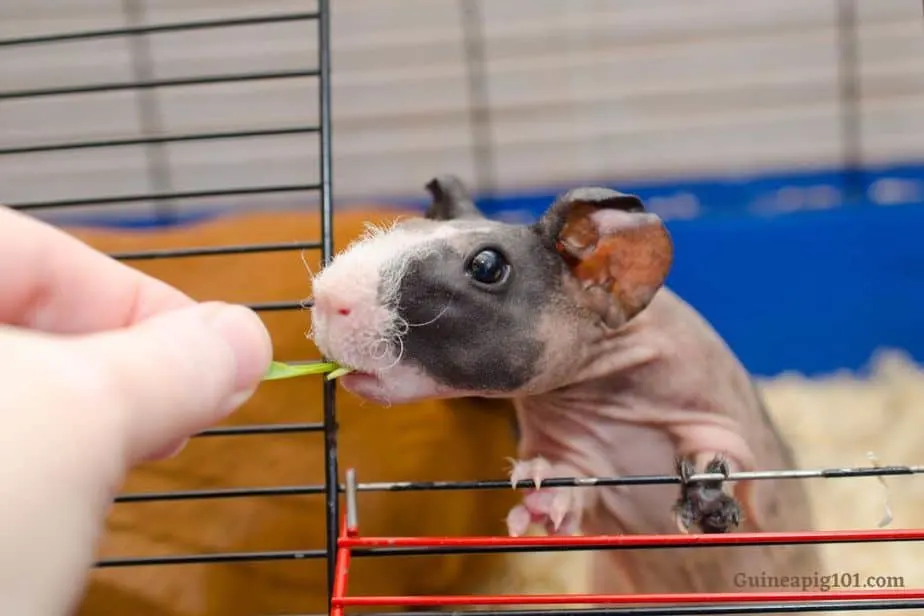
Treats are an excellent way to spice up the diet of your guinea pigs. They are also useful in taming your guinea pigs as it makes the process easier.
There is a wide range of commercial treat available in the market; however, not all of them are safe for your guinea pigs.
I usually serve commercial treat only once a week to my guinea pigs. The other great and healthy alternative is fresh fruits. It is also high in sugar; however, it contains a lot of vitamins and minerals in it as well.
My guinea pigs usually love Grapes, oranges, strawberry, apple, kiwi, etc. Only feed a small piece of a treat once or twice a week.
Don’t go generous by looking at your cute little guinea pigs. I usually serve fresh vegetables in midweek and commercial treats on the weekend.
Say, I gave them a piece of fruit on Wednesday, then the next treat they get will be on Sunday. Avoid feeding it frequently to avoid health issues like obesity, diabetes, etc.
Water
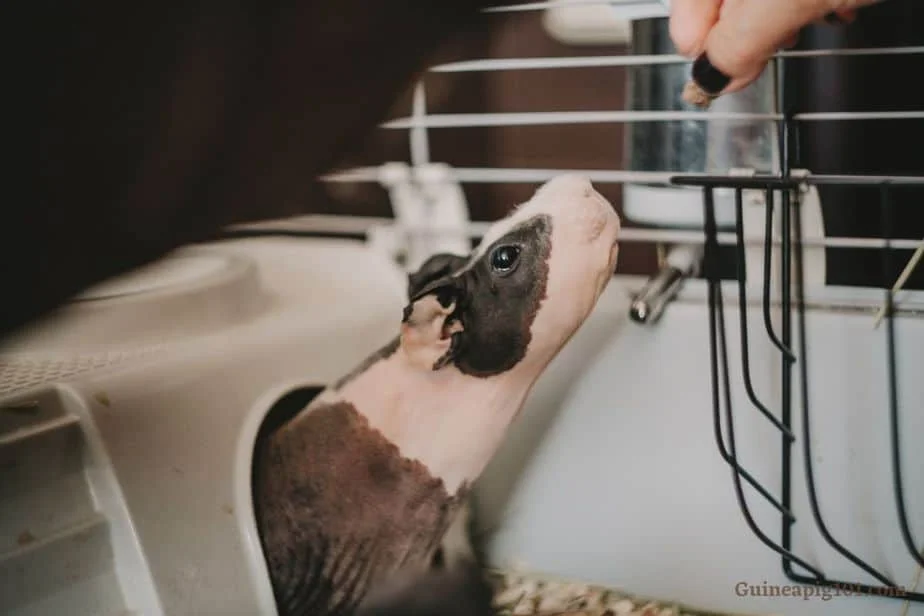
Water is also essential for your guinea pigs and should be provided to your guinea pigs at all times. An average guinea pig can drink anywhere between 50-300ml of water every day.
The consumption of water is dependent upon their diet, temperature, and various other factors. However, you must ensure they have fresh and clean water available 24×7.
You must also replace the water twice daily so that there is no bacteria buildup in it. If the water is warm or too cold, your guinea pigs might not drink it as they like water at room temperature only.
It would be best if you also used a good quality leakproof water bottle for providing water to your guinea pigs. Avoid using a water bowl as the water can get contaminated easily in those.
Skinny pig habitat

With diet out of the way now, let us have a look at the most basic stuff we need to house our guinea pigs. i.e., their habitat.
Guinea pigs need a large cage with bedding, toys, hiding spaces, water bottle, and food bowls, and skinny pigs are not much different. Skinny pigs also need all those necessary supplies.
However, there are a few things we need to do differently when we house skinny pigs. Let us check it out in brief.
Skinny pig cage setup
Many people believe that skinny pigs don’t require as much space as a usual guinea pig would. However, that is far from reality.
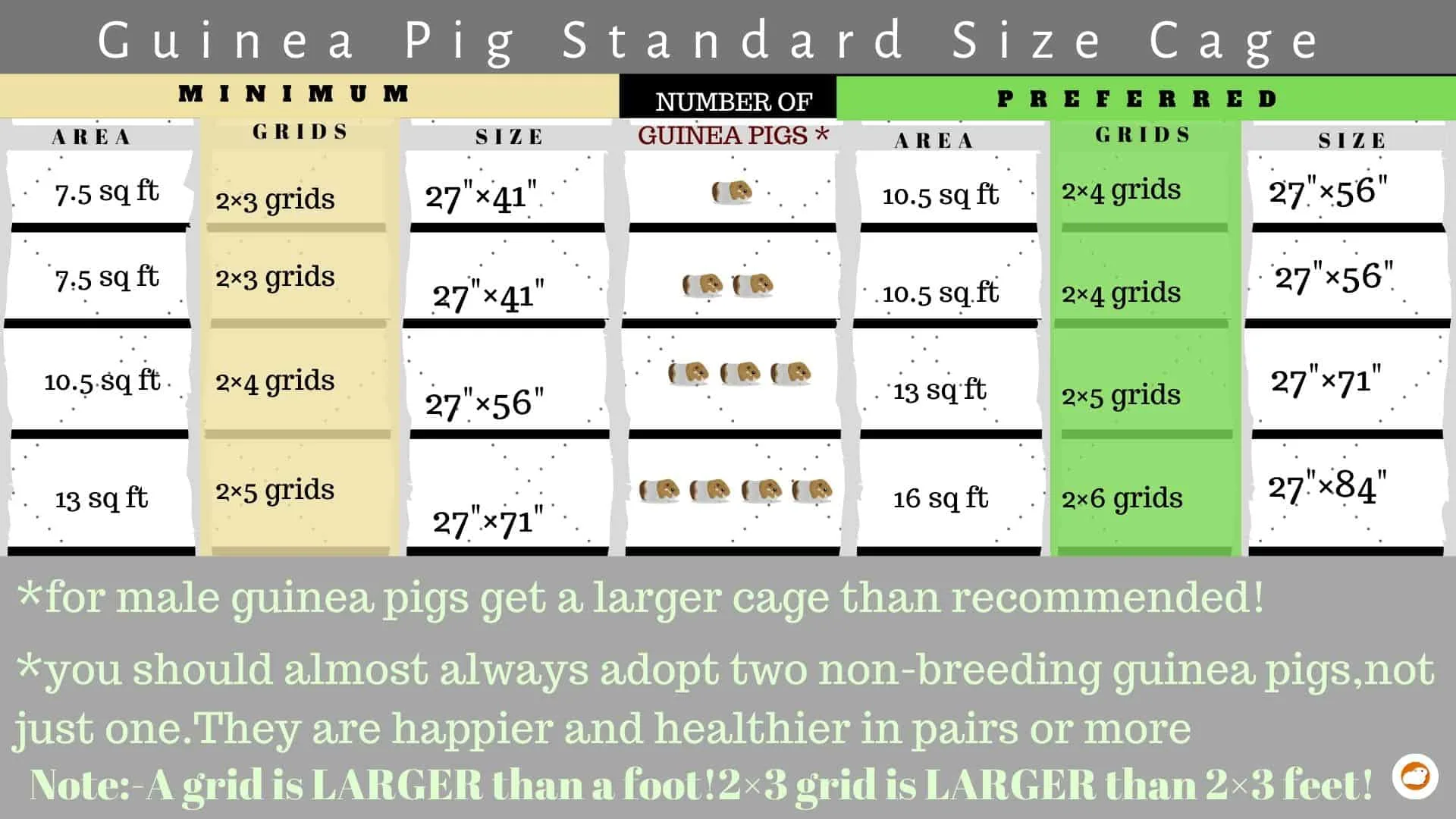
The fact is skinny pigs also need a reasonably large cage for living healthy. The minimum size of the pen you would need for a pair of the skinny pig would be around eight sq feet of space.
You should never go with a smaller cage as it would restrict their movement and exercise area, which can be terrible for their health.
Guinea pigs are caged animals, and they need to spend most of their time in the cage, so providing them with a large area to eat, play, and exercise would be ideal for them.
Now, one of the most important factors to consider while housing a skinny pig is the placement of the cage. Skinny pigs don’t have fur in their body, and thus, they can get cold pretty quickly.
Therefore, maintaining a stable and warmer environment is necessary to avoid health issues in them. The average temperature of the room should be around 22°C (71.6°F). You can get away with ±1°, but anything beyond could be a problem.
The cage should be placed in a well-ventilated area but away from drafts and direct sunlight. Also, make sure the pen has no sharp edges or something that can hurt your guinea pigs.
As they have no fur, their skin can get scratched pretty easily. So, if you are going for a DIY wooden cage or something, make sure it is well built.
Unfortunately, there are only a few readymade cages that can house our guinea pigs, providing enough space. In most cases, you have to go with either a MIDWEST cage DIY C&C cage for your guinea pigs.
Skinny pig bedding
Beddings are one of the critical factors while housing skinny pigs. Bedding plays a vital role in housing a guinea pig.
- It keeps the floor dry and the cage odor-free.
- Good quality bedding also protects the feet of your guinea pigs from the wired or rough bottom part of the cage.
- It provides an additional layer of insulation in the cage.
There is a wide variety of bedding available for guinea pigs right from aspen, paper, hay, fleece, etc. But not all of them are safe for skinny pigs.
While aspen and other wood shavings can bruise their skin easily, hay and paper bedding contains lots of dust and are not super absorbent to keep the piggies warm.
Thus, fleece remains one of the popular choice of bedding among skinny pig owners. However, the fleece needs frequent cleaning and upkeep as these piggies pee and poop a lot more than regular guinea pigs.
Skinny pig food bowl
Food bowls and hay racks are also crucial for a perfect cage setup. This helps in holding the hay and vegetables, pellets, etc. in place, which ensures that the cage remains clean, and it also makes the cleaning process really easy.
Skinny pig water bottle
Water bottles are also an essential part of the guinea pig’s cage. Guinea pigs need to have access to fresh and clean drinking water at all times.
We should use a leak-proof water bottle to ensure that the dripping water doesn’t soak the entire bedding.
Also, make sure you place the water bottle at adequate height for your guinea pigs. Usually, 1-2 inches high is the right height for placement, but you can experiment a little bit to find what works best for your piggies.
There is a lot more you need to learn about providing water to your guinea pigs. I would recommend you go through our in-depth guide on the water for your guinea pigs.
Skinny pig toys & hiding spaces
Skinny pigs need a lot more hiding spaces in their cage than other guinea pigs. Most experts recommend using some fleece hideouts and snuggle sacks to ensure your guinea pigs remain warm and feel secure.
Hiding spaces are must for guinea pigs as they weel safe and secured when they get into one. Guinea pigs are prey animals, and they look to sneak around the cage to take a good night nap.
Providing good quality toys is also essential for your guinea pigs. Guinea pigs need mental stimulation to keep themselves healthy and active. If you cannot offer them a few hours of floor time daily, it would be wise to add some toys into their cage so that they can play around.
However, the choice of toys should be much different for skinny pigs than other breeds out there. As skinny pigs have soft skin and no fur to protect their skin, you cannot go with any toys with rough or sharp edges.
Skinny pig grooming
Grooming skinny pig is really simple and straight forward. However, there are a few things you need to keep in mind while grooming them.
It is still easier to groom a skinny guinea pig than it is to groom a long-haired guinea pig breed like a sheltie.
Skinny guinea pigs regular grooming include nail clipping once a month, grease gland cleaning when needed, and looking out for dry skins and doing the needful if their skin gets dried.
They don’t need a regular bath until they get dirty and smelly or until a vet recommends it for some medical reasons.
So, with that out of the way let us have a closer look at their grooming and learn about it in brief.
Skinny pig nail care
One of the most common and routined parts of grooming a skinny pig is trimming their nails. Skinny pigs have a sharp nail, especially when they are young.
They can hurt your skin as well as their own, thus making sure you clip the nails down every month is necessary. Skinny pig’s nails grow quickly, and therefore you need to check it every month and trim them down.
It would help if you also used a nail filer to shape their nails so that they don’t have a sharp edge in it. If they end up hurting their skin or their cage mates with sharp nails, then it can be a terrible injury for them to recover back from. Thus, trimming and shaping it every month is essential.
Cutting the nail can be daunting, especially if you are a total beginner. I would recommend you take the help of a friend or visit a vet for the first time to see how it is done and try it next time.
A quick tip: You can hold your guinea pig by wrapping them in a towel and put their paws above a flashlight. You will be able to see through the nails and veins in them. Just be careful and use a good pair of clippers to clip off the new growth and you are good to go.
Skinny pig skincare
Skinny guinea pigs don’t have fur to protect their skin; thus they need some extra care to keep it in good shape. A healthy guinea pig living in a clean cage and having a proper diet should have a perfectly well-maintained skin.
However, sometimes they tend to have dry skin patches around their bodies and especially near their ears. In such a case, you should apply some organic coconut oil to make sure the skin remains moisturized.
Avoid using any chemical or fragranced based moisturizer as your guinea pig might ingest it while self-grooming them, and it can be bad for their health.
Also, you must ensure your skinny pig never comes in contact with direct sunlight. More prolonged exposure to the sun can lead to skin burn, and even cancer in some cases, so do keep that in mind.
Skinny pig grease gland
Grease glands are located at the back part of your guinea pigs. They usually use the grease secreted by these glands to mark their territory and attract female guinea pigs for mating.
Not all guinea pigs have an active grease gland, but some do. If your skinny pig has an active grease gland, then you might need to clean it out regularly as well.
Uncleaned grease glands can clog and lead to foul smell and infection in guinea pigs. It would be difficult to explain all about the grease gland in this article.
We have an in-depth article about grease glands and how to clean it. You can learn more about it from that article as well.
Skinny pig bath: Can I give my skinny pig a bath?
Guinea pigs usually keep themselves clean. There will hardly be any need for you to bath them unless they have some health issues or they have got to dirty.
In general, guinea pigs can groom themselves effectively, and you should not make bathing a routine task of their grooming schedule.
Bathing them frequently gets rid of all the natural oil in their skin, which can lead to dry and itchy skin. It would be wise to bath them only when needed or when your vets recommend you to do so.
How to bathe your skinny pig?
Bathing a skinny pig is relatively simple and straight forward. You can use a stable container and place it in the sink. Now put the guinea pig in it and add lukewarm water until the box fills till their navel.
Now you can pour the water around their body and use some gentle shampoo to lather them and clean your guinea pig. You must only use guinea pig safe mild shampoo as other shampoos can be harsh on their skin and can take away all the natural oil from the skin as well.
Once you are done lathering up, rinse thoroughly with water and wrap your guinea pigs with a soft towel. Make sure you absorb all the water from their body.
For other breeds, we use a hairdryer to dry them up, but you should not use it with skinny pigs as it can harm their soft skin and may even burn it if done incorrectly.
I would recommend Wrapping them in the towel, and taking them to a warm room could do the trick. Again, avoid direct sunlight and drafts to make sure your guinea pigs don’t fall sick. Also, apply some coconut oil once you are done with bathing.
Why is my skinny pig losing weight?
Weightloss in guinea pigs can be due to improper diet, dental problems, stress & other health issues.
However, body temperature is also a crucial factor to consider when it comes to skinny pigs. Skinny pigs don’t have fur in their bodies like other piggies; thus, they need to burn more calories to keep themselves warm.
If the temperature in the room below 70 degrees Fahrenheit then their body will start burning more calories to keep it warm. This usually causes weight loss in skinny pigs.
Most owners don’t consider or take those temperatures seriously, but that is one of the significant factors to consider, especially if you own a skinny pig.
I have also written an in-depth article about why do guinea pigs lose weight and what can you do about it. If you are still unsure about it I would recommend reading that out.
How to keep skinny pig warm?
It is recommended using a heater with a thermostat.
I often set it around 72-74 degrees Fahrenheit, and my piggies are good to go. It is definitely recommended using one of these, especially if you live in a colder region.
You can also use snuggle sacs, microwave-safe heat pads, etc. that can help if the temperature goes very low.
There are a lot more ways to keep your guinea pig warm. I have a whole article on it. If you want to learn more about it, read our in-depth guide on it.
Why is my skinny pig shaking?
Skinny pigs usually shake either due to cold, joy, or fear. If your guinea pig is shaking out of pleasure, then there is nothing to worry about.
However, stress or cold can also lead to shaking in guinea pigs, and you might need to look into it.
I would definitely recommend reading our in-depth guide on What causes shaking in guinea pigs and what you can do about it so that you can learn everything about it.
Where to buy skinny pigs?
Skinny guinea pigs are available in rescues, pet shops, and some breeders as well. I would definitely not recommend buying one from a pet shop as these piggies are not treated well, and thus, they don’t have a high life expectancy.
I would personally recommend looking out for rescues in your area to find a skinny pig. If they are not available in the rescues, you can look around and search for some professional breeders with an excellent reputation to get one.
Always make sure you watch out for signs of healthy guinea pigs before getting one for your family.
How much does a skinny pig cost?
Skinny pigs can cost you anywhere between 100$ to 200$ price range on average. While the rescues give it at the cost of the 125-150$ price range, the cost can rise significantly to even 300$ if you get it from a breeder.
Being a rare species that is hard to breed justifies why the value of skinny pigs is so high. You must also consider that they are a social animal, and you need to buy at least a pair to ensure they live healthy & happy.
Are skinny pigs hypoallergenic?
No, skinny pigs are not hypoallergenic. Most people believe that since skinny pigs don’t have a coat, they are hypoallergenic.
While that is far from real, Any warm-blooded animal can cause an allergic reaction to human beings through dander, urine, or saliva.
Hay and beddings are also a primary culprit of allergy, which most people don’t realize early on.
If you are allergic to guinea pigs but still want to own one anyway, then you must definitely read our guide on that: Are Guinea Pigs Hypoallergenic? Tips for families with guinea pig allergies!
Conclusion:
- A Skinny pig need a cage of atleast 7.5 sq feet area.
- Quality bedding is must to ensure your guinea pigs remain healthy and their cage remains clean. Use fleece bedding if possible.
- Providing a good quality balanced diet is a must. Go for good quality hay along with a cup of fresh veggies daily and followed by some pellets and treats.
- Make sure you provide them with enough floor time to play and exercise.
- Although the skinny pigs doesn’t have much grooming needs they do need some care on a monthly basis. Nail trimming and skin care are some basic essential to look out for.
- Skinny pigs also have fast growing nails which needs regular clipping. If you don’t file them regularly the sharp nails might hurt their cage mates or even you while you hold them.
- Make sure you bath your skinny pig only when it is required. Bathing them frequently can rip off the natural oil in the skin making it rough and dry.
- Regular vet visit(once in 3 months) helps in preventing diseases so that your guinea pigs can live a long and healthy life.
- While going to get one always ensure that they are healthy. A healthy coat, glowing eyes, good sound, and good dental health helps identify the right one. It is best to get your first guinea pigs from a rescue or a breeder only.
FAQ
Are skinny pigs cuddly?
Yes, skinny pigs are definitely cuddly as compared to other guinea pig breeds. They have an outgoing and calm personality, which makes them easy to tame.
Are skinny pigs easy to take care of?
No, skinny pigs are definitely not easy to take care of when you compare them with other breeds. Since they need special attention and have more dietary needs than other piggies, they also pee and poop a lot more, which means frequent cleaning and other chores as well.
Are skinny pigs smelly?
No, skinny pigs don’t smell usually. They like to keep themselves clean. However, their enclosure might smell bad if we don’t keep up with the regular cleaning schedule. Learn more about it at How to keep guinea pig’s odor-free.
Do skinny pigs need special care?
Yes, skinny pigs do need some special care. Maintaining the right temperature, cleaning the cage more often, and grooming them right are some of the extra jobs you need to do for them.
Can you keep skinny pigs outside?
No, skinny pigs are not meant to be kept outside. Unlike other breeds, they don’t have any hair in their bodies to keep themselves warm. Thus, a fluctuating environment can be fatal for their health.
Is a skinny pig a good pet?
Yes, a skinny pig is definitely a rewarding pet. They do need some extra care, but if you can keep up with them, they are really calm and affectionate pets for your family.
Do skinny pigs and guinea pigs get along?
Yes, skinny pigs can live with other breeds of guinea pigs. However, you need to make sure that other guinea pigs are not very aggressive or dominant as they can hurt your skinny pig if they get aggressive. Skinny pigs don’t have hair to protect their bodies. Thus even a slight nibble can harm their skin bad.
Do skinny pigs like to be held?
Yes, skinny guinea pigs are more social and affectionate than other guinea pigs breed. However, make sure you don’t expect too much from them at the beginning. All guinea pigs carry a different personality, and the traits may differ a lot depending upon the behavior of your guinea pig.
Sources: Housing Guinea pig colony, Guinea pigs housing, Petsaver guinea pig guide, Guinea pig care, GUINEA PIG GENERAL CARE GUIDE, The effects of lowering the bath temperature, Weight Loss in Guinea Pigs, THE DEPLETION OF VITAMIN C, Discussion with a vet, The Journal of Nutrition, NCBI, NCBI, Journal of animal health, Petmd, The Effects of Diet on Anatomy, Physiology, and Health in the Guinea Pig.
